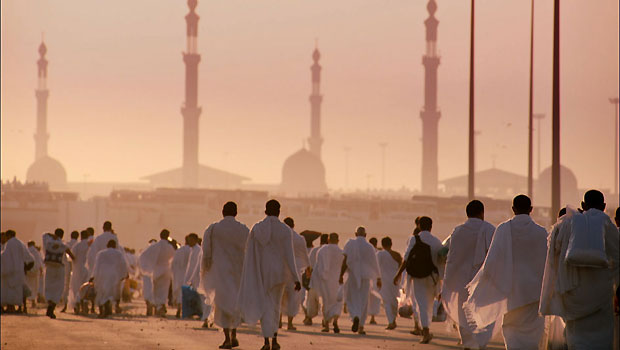
Image of Muslim pilgrims during the Hajj. (Credit: British Museum)
London, Asharq Al-Awsat—It appears that the successful exhibition of Hajj: Journey to the Heart of Islam that took place at London’s British Museum in January 2012 has tempted other international museums and art institutions to host similar exhibitions.
In the next few months there will be exhibitions on the Hajj, the main Muslim pilgrimage, at the Museum of Islamic Art in Doha, the Arab World Institute (AWI) in Paris and the National Museum of Ethnology in Leiden, Netherlands.
Speaking exclusively to Asharq Al-Awsat, Venetia Porter, assistant keeper in the Department of the Middle East at the British Museum and the one in charge of the Hajj exhibition, said: “Several cities expressed their desire to hold the Hajj exhibition. Many hoped that the exhibition would make a tour, but because we have borrowed most of the items, it was impossible to lend them to any other museums. However, we decided that we could lend the scientific and research material to the museums planning to hold similar exhibitions.”
“Most of the items we exhibited are borrowed from 40 sources,” such as Al-Khalili Group, the British Library and the King Abdulaziz Library in Riyadh, she added.
While the British Museum’s exhibition traced the ancient Hajj routes through Africa (and particularly Timbuktu, Mali), the exhibitions in Doha, Paris and Leiden will tackle different aspects of the Muslim holy journey of Hajj. Porter said the Hajj: The Journey through Art in Doha will focus on Qatari art collections; therefore, they will not need the items exhibited in the British Museum.
“As for the Leiden exhibition [Longing for Mecca: The pilgrim’s journey], it will be very interesting. The exhibition will differ in terms of the stories told by Muslims there. The museum in Leiden borrowed the same items we exhibited here; however, they developed their own storyline.”
The Paris exhibition will tackle a different aspect of Hajj. Due to France’s geographical proximity to North Africa and the proportion of North African immigrants in the country, the exhibition is set to trace the historical and cultural ties between the two cultures.
What distinguished the British Museum’s exhibition is its contemporary aspect by showcasing contemporary works of art about Hajj, an aspect which will be covered in the forthcoming exhibitions, Porter added.
Paris
Next year, the AWI will hold an exhibition on the past and future of Hajj. Items on display will be borrowed from several French museums and Saudi institutions.
Speaking to Asharq Al-Awsat, Muna Khazindar, the AWI’s president said: “We are trying to persuade some owners in Saudi Arabia to lend us some of the rare items related to the journey of Hajj.”
Khazindar stressed that both the number and the identity of the items that will be exhibited are not yet known; however, the AWI will borrow items from “King Saud University, Bibliothèque nationale de France (BnF) and several other French museums.”
When we asked her whether the AWI is coordinating with the other two sides that will host the Hajj exhibition, Khazindar revealed that each side “works alone and prepares for the exhibition in their own way.”
Khazindar confirmed that there will be contemporary items in the AWI version of the exhibition.
“We have not determined what works to exhibit; however, the Saudi artists who dealt with Hajj are well-known, such as Ahmed Mater and Shadia Alem.”
Doha
On October 9, 2013 the Museum of Islamic Art in Doha will hold Hajj: The Journey through Art, tackling the artistic aspect of the Muslim holy journey of Hajj. Despite being based on the British Museum’s exhibition, 90 percent of the Doha items will come from Qatari art collections.
The exhibition will examine the holy journey from a unique perspective by focusing on three main issues: the routes taken by pilgrims, Hajj rituals from an artistic perspective, and the experience of pilgrims during the Hajj and on their way back from Mecca.
Dr. Munia Shikhab Abu Daya, the keeper of manuscripts at Doha’s Museum of Islamic Art, will be in charge of the exhibition and have stressed that some of the items on display have never been exhibited before.
Leiden
The National Museum of Ethnology in Leiden, Netherlands, will hold Longing for Mecca: The pilgrim’s journey from September 10. It will present different pictures of the ancient Hajj routes through eastern Asia.
Laut Mollz, the coordinator of the exhibition, told Asharq Al-Awsat that the exhibition “aims at communicating with Muslims here.”
“In collaboration with the British Museum, we will be able to exhibit some of the items that were on display in London. However, we will concentrate on the items from the Netherlands. For example, the Amsterdam University Library owns a very valuable collection, as does the Troben Museum,” Mollz explained.
Among its items, Longing for Mecca: The pilgrim’s journey will include photos dating back to the 19th.
Besides this, the exhibition will allocate an entire section narrating anecdotes told by pilgrims of Moroccan, Turkish, Somali, Iranian and Iraqi origins. The exhibition will also highlight the Hajj routes from Indonesia, given its importance as a former Dutch settlement.

Trackbacks/Pingbacks